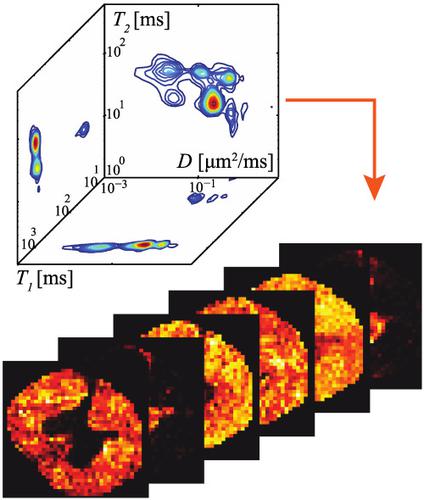当前位置:
X-MOL 学术
›
NMR Biomed.
›
论文详情
Our official English website, www.x-mol.net, welcomes your
feedback! (Note: you will need to create a separate account there.)
Multidimensional correlation MRI.
NMR in Biomedicine ( IF 2.7 ) Pub Date : 2020-01-07 , DOI: 10.1002/nbm.4226 Dan Benjamini 1, 2 , Peter J Basser 1
NMR in Biomedicine ( IF 2.7 ) Pub Date : 2020-01-07 , DOI: 10.1002/nbm.4226 Dan Benjamini 1, 2 , Peter J Basser 1
Affiliation

|
Multidimensional correlation spectroscopy is emerging as a novel MRI modality that is well suited for microstructure and microdynamic imaging studies, especially of biological specimens. Conventional MRI methods only provide voxel‐averaged and mostly macroscopically averaged information; these methods cannot disentangle intra‐voxel heterogeneity on the basis of both water mobility and local chemical interactions. By correlating multiple MR contrast mechanisms and processing the data in an integrated manner, correlation spectroscopy is able to resolve the distribution of water populations according to their chemical and physical interactions with the environment. The use of a non‐parametric, phenomenological representation of the multidimensional MR signal makes no assumptions about tissue structure, thereby allowing the study of microscopic structure and composition of complex heterogeneous biological systems. However, until recently, vast data requirements have confined these types of measurement to non‐localized NMR applications and prevented them from being widely and successfully used in conjunction with imaging. Recent groundbreaking advancements have allowed this powerful NMR methodology to be migrated to MRI, initiating its emergence as a promising imaging approach. This review is not intended to cover the entire field of multidimensional MR; instead, it focuses on pioneering imaging applications and the challenges involved. In addition, the background and motivation that have led to multidimensional correlation MR development are discussed, along with the basic underlying mathematical concepts. The goal of the present work is to provide the reader with a fundamental understanding of the techniques developed and their potential benefits, and to provide guidance to help refine future applications of this technology.
中文翻译:

多维相关 MRI。
多维相关光谱作为一种新型 MRI 模式正在兴起,非常适合微观结构和微动态成像研究,尤其是生物样本。传统的 MRI 方法仅提供体素平均信息和大部分宏观平均信息;这些方法无法基于水流动性和局部化学相互作用来消除体素内的异质性。通过关联多个 MR 对比机制并以集成方式处理数据,相关光谱能够根据水体与环境的化学和物理相互作用来解析水体的分布。使用多维 MR 信号的非参数现象学表示,不对组织结构做出任何假设,从而可以研究复杂异质生物系统的微观结构和组成。然而,直到最近,大量的数据需求将这些类型的测量限制在非局部核磁共振应用中,并阻止它们与成像结合广泛而成功地使用。最近的突破性进展使这种强大的 NMR 方法能够迁移到 MRI,从而使其成为一种有前途的成像方法。本综述无意涵盖多维 MR 的整个领域;相反,它侧重于开创性的成像应用和所涉及的挑战。此外,还讨论了多维相关 MR 发展的背景和动机,以及基本的数学概念。 目前工作的目标是让读者对所开发的技术及其潜在好处有一个基本的了解,并提供指导以帮助完善该技术的未来应用。
更新日期:2020-01-07
中文翻译:

多维相关 MRI。
多维相关光谱作为一种新型 MRI 模式正在兴起,非常适合微观结构和微动态成像研究,尤其是生物样本。传统的 MRI 方法仅提供体素平均信息和大部分宏观平均信息;这些方法无法基于水流动性和局部化学相互作用来消除体素内的异质性。通过关联多个 MR 对比机制并以集成方式处理数据,相关光谱能够根据水体与环境的化学和物理相互作用来解析水体的分布。使用多维 MR 信号的非参数现象学表示,不对组织结构做出任何假设,从而可以研究复杂异质生物系统的微观结构和组成。然而,直到最近,大量的数据需求将这些类型的测量限制在非局部核磁共振应用中,并阻止它们与成像结合广泛而成功地使用。最近的突破性进展使这种强大的 NMR 方法能够迁移到 MRI,从而使其成为一种有前途的成像方法。本综述无意涵盖多维 MR 的整个领域;相反,它侧重于开创性的成像应用和所涉及的挑战。此外,还讨论了多维相关 MR 发展的背景和动机,以及基本的数学概念。 目前工作的目标是让读者对所开发的技术及其潜在好处有一个基本的了解,并提供指导以帮助完善该技术的未来应用。











































 京公网安备 11010802027423号
京公网安备 11010802027423号